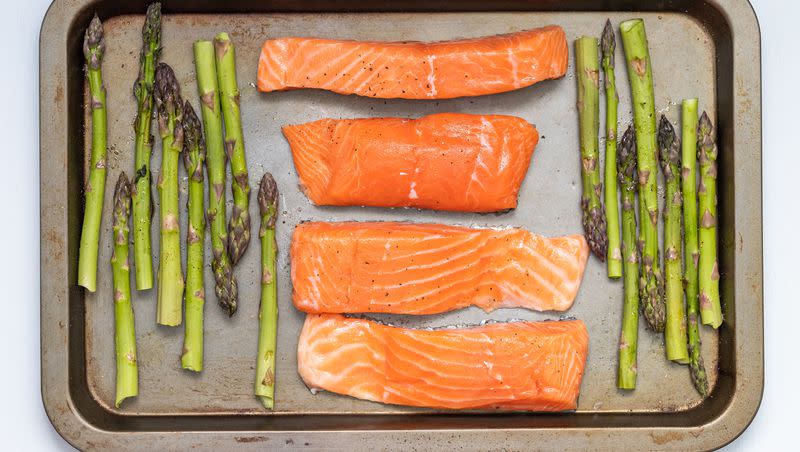The rules of the Mediterranean diet

The Mediterranean diet has been touted for its health benefits and the philosophy behind it — it’s a lifestyle, not just a diet.
Periodically, new research comes out about this way of eating, which typically shows the different ways this diet is beneficial. Here’s a more in-depth look at what the Mediterranean diet is and the benefits it has.
Related
What is the Mediterranean diet?
The Mediterranean diet is a way of eating which involves eating vegetables, whole grains, extra virgin oil, fish and limited amounts of meat typically poultry. According to Cleveland Clinic, this lifestyle emphasizes healthy fats and limited amounts of sugar.
The diet is named after the Mediterranean basin. According to the Mayo Clinic, people who live in countries around the Mediterranean Sea have traditional cuisines which encompass this way of eating. Fruits, nuts, legumes, herbs and spices are also commonly consumed in a Mediterranean diet. In order to eat a Mediterranean diet, using olive oil instead of butter and eating more fish, beans and whole grains is a good way to start.
Related
What foods can you eat on a Mediterranean diet?
The Mediterranean diet involves eating vegetables, fish, whole grains, beans, fruit and limiting consumption of sugar and unhealthy fats.
Some foods one could consume on a Mediterranean diet are chickpeas, lentils, black beans, red beans, quinoa, feta cheese, Greek yogurt, salmon, rainbow trout, hummus, leafy greens, broccoli, tomato, walnuts, almonds, strawberries, cantaloupe and other foods which fit within those categories.
On a Mediterranean diet, processed foods should be limited, according to The Mediterranean Dish. It happens naturally when one eats a Mediterranean diet because foods with high amounts of sodium and sugar aren’t part of the Mediterranean diet.
Related
Why is the Mediterranean diet so healthy?
The Mediterranean diet is so healthy because it focuses on eating whole grains with proteins and vegetables. Due to the way the Mediterranean diet works, unhealthier foods will be eaten less since they aren’t the focal point of the diet.
The Mayo Clinic said, “Overall, the diet emphasizes whole, minimally-processed foods. It focuses on filling its followers’ plates with mostly plants, rather than red meat, and leans on a variety of flavors that enhance—instead of hurt—your health.”
There’s also ways to make foods Mediterranean diet compliant.
Take for example, fries. Instead of frying a potato for french fries, cutting up a sweet potato and tossing it with olive oil and some spices and then baking it in the oven can be a good substitute. Instead of eating a piece of pizza, one could also take a whole wheat tortilla and add some pizza sauce on top with a light sprinkling of cheese and some vegetables.
Some baking tricks like switching out all-purpose flour for whole wheat flour and using stevia instead of sugar can be good ways to make desserts that are more friendly to the Mediterranean diet.
What is the typical Mediterranean breakfast?
There are many iterations of a typical Mediterranean breakfast.
Mediterranean Living gave some examples like overnight oats, sweet potato hash with eggs, frittata, avocado toast and yogurt with honey. A good rule of thumb when it comes to breakfast is to include a whole grain, a protein and a healthy fat.
Many egg dishes, whether scrambled or an omelette or over-easy, would work well for a Mediterranean diet. Oatmeal or buckwheat is also a good option. For toast, you can try egg on toast or ricotta on toast — using a whole grain bread with nuts and seeds on the outside is a good option.
What is the typical Mediterranean lunch or dinner?
For lunch or dinner, consider having a piece of fish with vegetables like sweet potato or broccoli or steamed leafy greens. You could also have an omelette or quiche with a side salad. Another option is a bowl with quinoa, cucumbers, tomatoes, chickpeas and hummus with a fresh squeeze of lemon.
A salad with beans would work and so would some fish, rice and a strawberry spinach salad. Creating a formula for lunches and dinner is a good way to stay on track with the diet. Eating a whole grain with a protein and some vegetables is a good formula to follow. Fresh fruit can work as a snack or dessert.
Related
Mediterranean diet recipes
Here are some recipes from different websites.
Ahead of Thyme’s spring vegetable frittata.
Eating Well’s skillet eggs with tomatillos and spinach.
All Recipes’ cavatelli and broccoli.
Ahead of Thyme’s Mediterranean orzo pasta salad.
Eating Well’s salmon rice bowl.
Ahead of Thyme’s grilled shrimp salad.
Eating Well’s roasted vegetables and hummus pita pockets.
Benefits of a Mediterranean diet
There are several benefits to a Mediterranean diet including lowering the risk of certain diseases. The Harvard School of Public Health said, “Those who had the highest adherence to a Mediterranean diet showed a 24% lower risk of cardiovascular disease and 23% lower risk of premature death compared with those who had the lowest adherence.”
Reporting for Deseret News, Madison Selcho said the Mediterranean diet has been shown to reduce brain atrophy, can aid in longevity of life and prevents cardiovascular diseases. Americans typically aren’t eating enough vegetables and fruits in their diet, which means changing to this lifestyle would be a good way to incorporate more fruits and vegetables.
